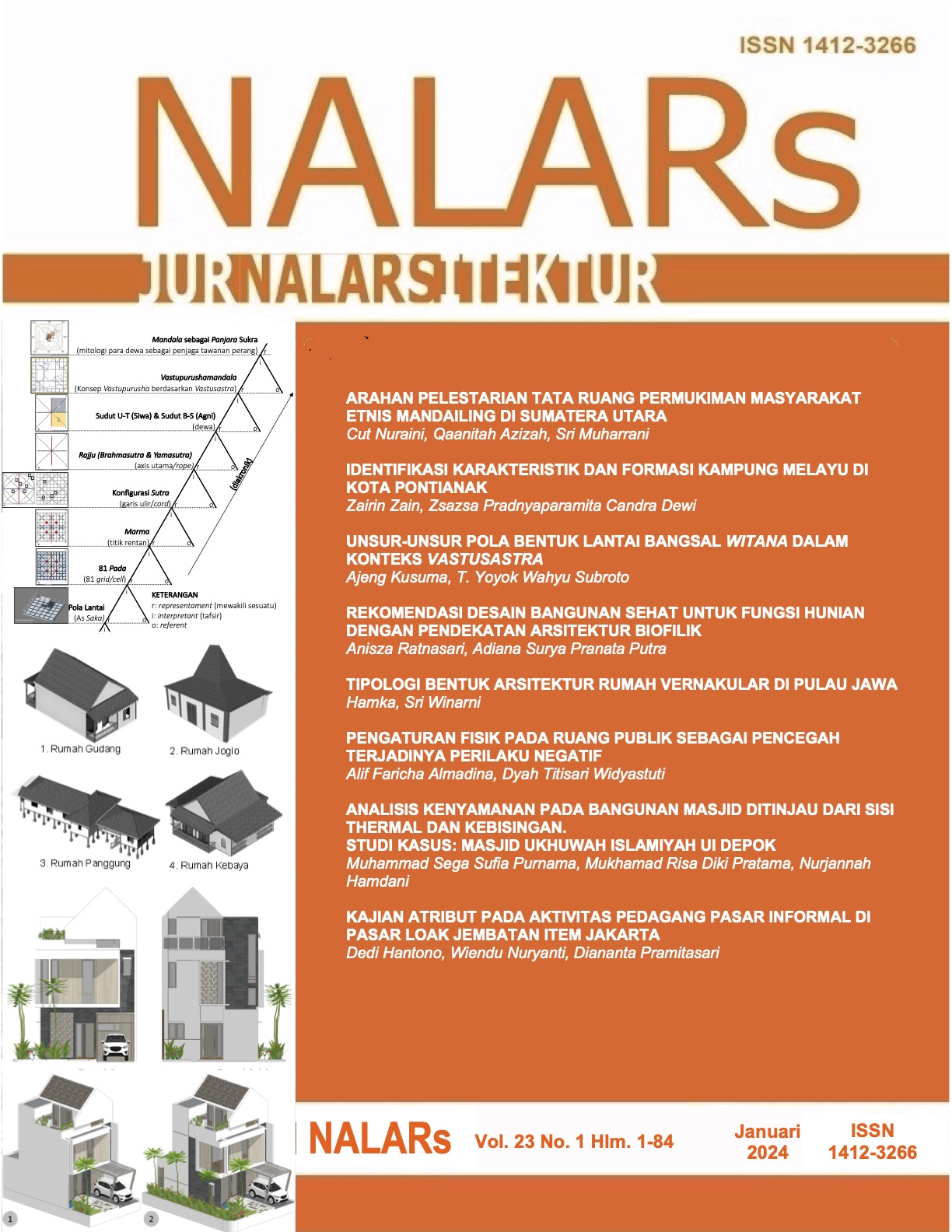UNSUR-UNSUR POLA BENTUK LANTAI BANGSAL WITANA DALAM KONTEKS VASTUSASTRA
DOI:
https://doi.org/10.24853/nalars.23.1.29-38Keywords:
Pola Lantai, Vastusastra, Bangsal Witana, Keraton YogyakartaAbstract
Ngayogyakarta Hadiningrat Palace means realizing values based on local knowledge as a civilization indicator. Fact Yogyakarta palace, as the center of Javanese culture, is maintained and exists through intangible and tangible aspects. The reality of the distribution of local Javanese values, such as Javanese philosophy and way of life, is threatened among the younger generation. The physical revitalization of the Yogyakarta Palace on public crisis awareness of understanding philosophical meaning circulating. Understanding that Yogyakarta Palace's symbolic meaning can be learned through buildings, especially in the Witana ward, is vital. Witana has complete ornaments full of symbolic meaning by focusing on the floor as one of the architectural building's elements. What does the floor look like in Witana Ward? What is the process of the relationship between geometric shapes and meaning? What is the symbolic meaning of the Witana Ward floor pattern? Consider Witana's architectural symbol to invite all people to remember God Almighty. The research is urgent to formulate floor shapes in Witana Ward to formulate the relation between geometric shapes and meanings and formulate the symbolic meaning of floor patterns in Witana Ward, Yogyakarta Palace. The semiotic method with Peirce and Chandler's analytical model examines Ward Witana architectural forms, namely icons, indexes, and symbols, in a triadic system. The application of this method in the study of the elements of the Witana Ward floor pattern is to uncover latent factors to produce truths through local knowledge. The result is a system consisting of three sign components, built from floor pattern objects that have a relationship with Vastusastra as context. Keraton Ngayogyakarta Hadiningrat adalah salah satu sarana perwujudan nilai (value) berdasarkan pengetahuan lokal yang dapat menjadi indikator perkembangan peradaban. Fakta bahwa Keraton Yogyakarta sebagai centrum kebudayaan Jawa yang masih terjaga dan eksis, dibuktikan melalui dua aspek yakni intangible serta tangible. Realitanya distribusi nilai lokal Jawa seperti filosofi kejawaan hingga pandangan hidup semakin terancam di kalangan generasi muda. Revitalisasi fisik Keraton Yogyakarta tentunya didasari kesadaran terhadap krisis pemahaman makna filosofis yang beredar di lingkungan publik. Vitalnya pemahaman mengenai makna simbolik di Keraton Yogyakarta dapat dipelajari melalui bangunan sebab memuat makna simbolik lengkap, khususnya di Bangsal Witana. Bangsal Witana memiliki kelengkapan ornamen sarat makna simbolik dengan berfokus pada lantai sebagai salah satu elemen penting pembangun Arsitektur. Seperti apa bentuk lantai di Bangsal Witana? Bagaimana proses relasi antar bentuk geometri dengan makna? Apa makna simbolik pola lantai Bangsal Witana? mengingat Bangsal Witana merupakan simbol Arsitektural guna mengajak seluruh rakyat untuk mengingat Tuhan Yang Maha Esa. Hal ini sejalan dengan urgensi penelitian untuk merumuskan bentuk lantai di Bangsal Witana, merumuskan proses relasi antar bentuk geometri dengan makna, serta merumuskan makna simbolik pola lantai di Bangsal Witana, Keraton Yogyakarta. Metode semiotika dengan model analisis milik Peirce dan Chandler, dimana mengkaji bentuk Arsitektur Bangsal Witana dalam sistem triadik yaitu ikon, indeks, dan simbol. Aplikasi metode tersebut dalam kajian unsur pola bentuk lantai Bangsal Witana guna mengungkap faktor laten sehingga menghasilkan kebenaran sesuai dengan pengetahuan lokal. Hasilnya berupa sistem yang terdiri dari tiga komponen tanda, terbangun dari objek pola lantai yang memiliki relasi dengan Vastusastra sebagai konteks.References
Achyuthan, & Prabhu, B. (1998). Manuṣyālayacandrika: An Engineering commentary. In Vastuvidyapratisthanam (Vol. 2). Vastuvidyapratisthanam.
Ambarwati, D. R. S. (2009). KONTINUITAS DAN PERUBAHAN VASTUSASTRA PADA BANGUNAN JOGLO YOGYAKARTA. FBS UNY, 1–30.
Babu, B. N. (1997). HANDBOOK OF VASTU. UBS Publishers’ Distributors Pvt. Ltd.
Chandler, D. (2007). Semiotics the Basics (Second Edi). Routledge. https://doi.org/10.1016/S0378-2166(02)00176-5
Dwiyanto, D. (2009). Ensiklopedia Kraton Yogyakarta. Dinas Kebudayaan DIY.
Hatmoko, A. U. (2020). Kreativitas serta Tradisi dan Inovasi dalam Pendidikan Arsitektur. Vol. 5 No. 1: SMART #5 - Seminar on Architecture Research & Technology, 51–56.
Peirce, C. S. (1986). La Ciencia de La Semiotica. Ediciones Nueva Vision.
Priyono, U., Pratiwi, L., Tanudirjo, D. A., Suwito, Y. S., Suyata, & Albiladiyah, I. (2015). Yogyakarta City of philosophy. Dinas Kebudayaan DIY.
Roshen, D. (2019). HINDUISM: An Alphabetical Guide. Penguin Books.
Subroto, T. Y. W. (2019). Koeksistensi alam dan budaya dalam Arsitektur. v–vii.
Sukirman. (2011). Ragam Hias Bangsal Witana Sitihinggil Utara Keraton Yogyakarta, Kajian Ikonografis. Pascasarjana Institut Seni Indonesia Yogyakarta.
Sumalyo, Y. (2021). Sejarah, Arsitektur, dan Tata Ruang Keraton Yogyakarta. Jakarta: Realrich Architecture Workhop.
Toorn, M. van den, & Guney, A. (2011). Precedent Analysis in Landscape Architecture. Diversity and Unity: Proceddings of IASDR2011, 4th World Conference on Design Research, 11.
Wardani, L. K., Soedarsono, R. M., Haryono, T., & Suryo, D. (2011). GAYA SENI HINDU–JAWA PADA TATA RUANG KERATON YOGYAKARTA. DIMENSI INTERIOR, 9(2), 108–118.
https://talkingmyths.com/when-shiva- swallowed-shukra/ diakses 11 November 2022 pukul 11.33 WIB.


